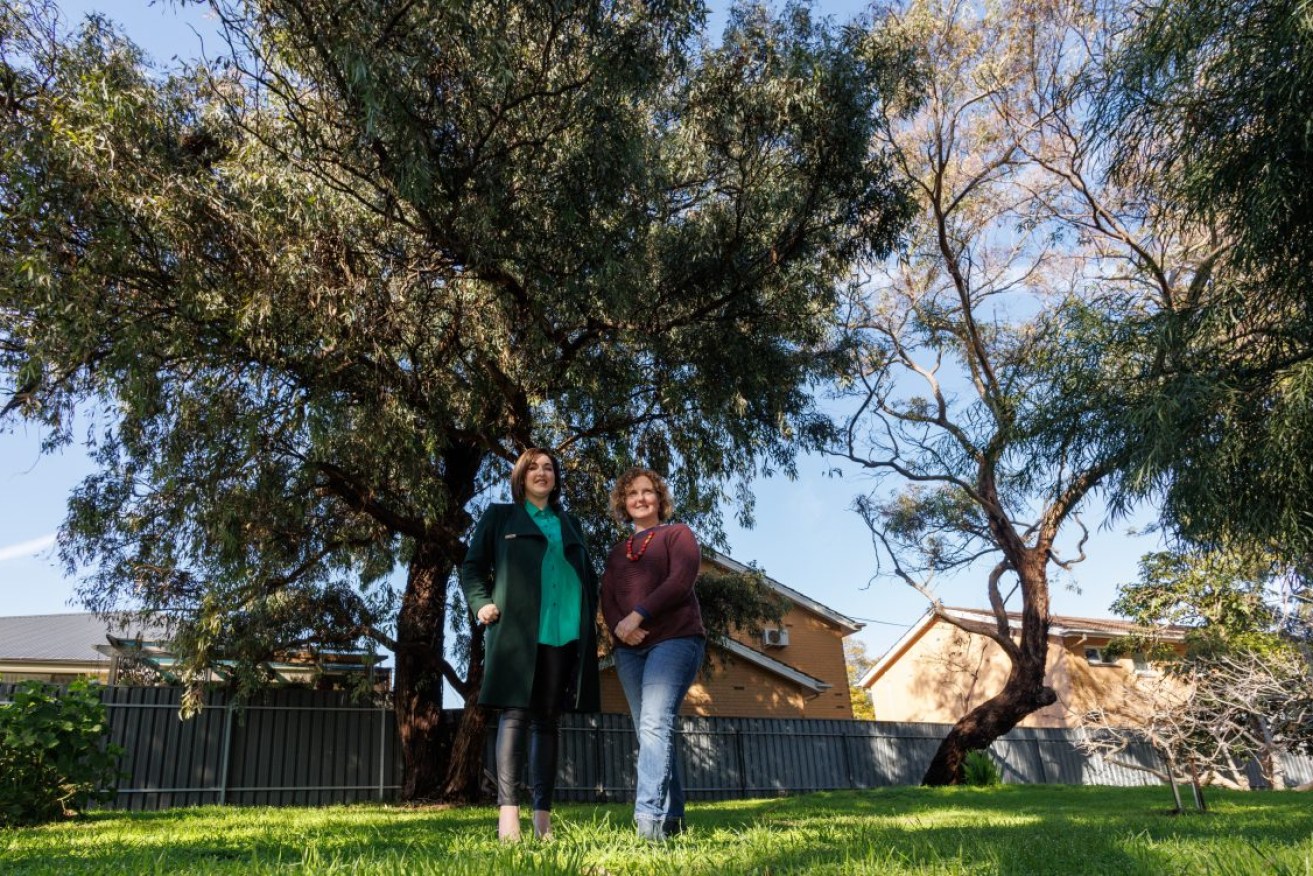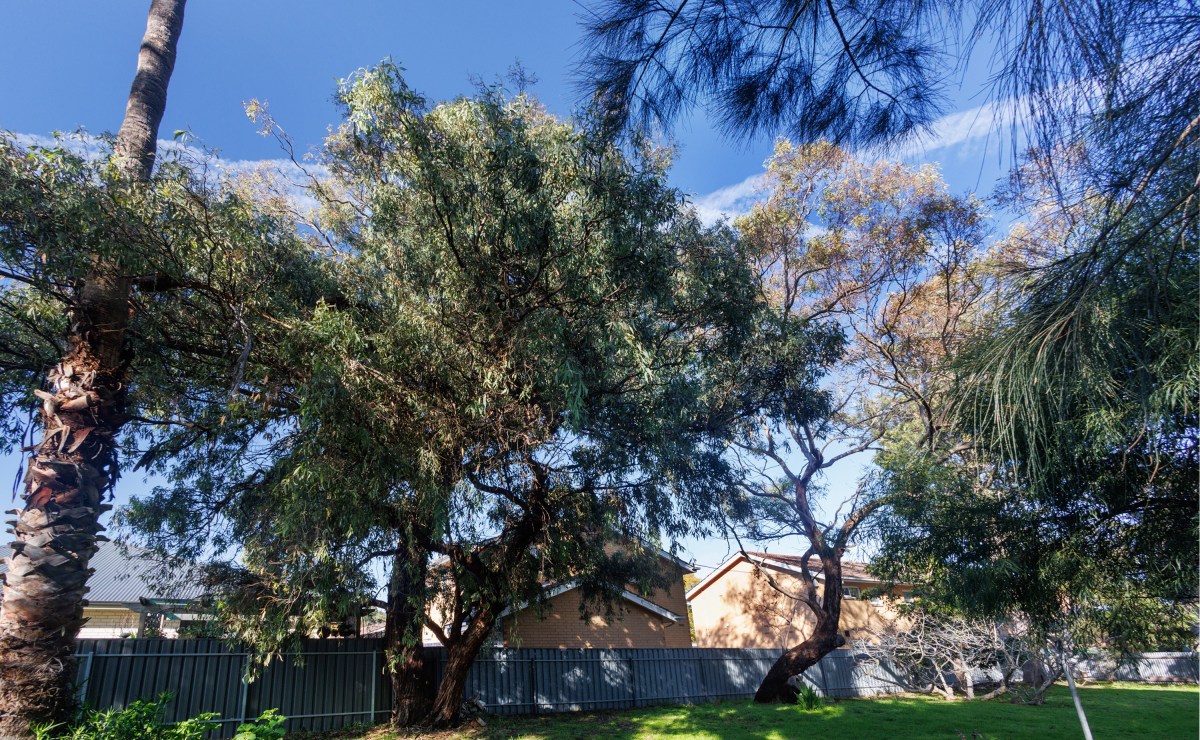Govt buys suburban block to save significant trees
Two surviving remnant grey box trees in Black Forest – the Adelaide suburb named after a now-vanished woodland – have been saved from the threat of the developers’ axe after the state government stepped in to buy the house and land on which they stand.

MP Jayne Stinson and resident Kate Hubmayer with two grey box trees at Black Forest. Photo: Tony Lewis/InDaily
The trees which predate European settlement are sited on a large Winifred Avenue block with a 1920s bungalow, but local fears were raised when the property was put up for sale in June.
Winifred Avenue resident Kate Hubmayer said the site was attractive for urban infill.
“I was really worried that the whole block might be developed, because it’s such a large block (1503 m²),” she said.
“There was potential to put many townhouses on it.”
A real estate firm pitched the site sale as “a mammoth opportunity, subject to council consents of course, to build one, two, three, or four, maybe just your dream home”.
While the trees are both “regulated” and protected due to their size, locals believed that was no real guarantee of their continued survival.
“Even trees that are on Significant Tree List registers just vanish over time, which is just horrible, it’s really upsetting,” Hubmayer said.
“I didn’t want that to happen to these ones, because they’re so precious and historic. They’re what Black Forest was named after, the beautiful mottled grey bark.”

The grey box trees. Photo: Tony Lewis/InDaily
The property was passed in at auction in July and local MP Jayne Stinson said “passionate” locals asked for help to protect the trees for their “cultural and historical value” as well as their environmental value.
Stinson lobbied her state government colleagues and it was agreed to make an offer for the property, with the state government paying $1.4 million for the site.
About 800 square metres of green space at the rear will join Forest Avenue Reserve, which includes the Black Forest Primary School oval, while the remaining 701 square metres will be sold to recover costs.

Part of the land will added to a neighbouring reserve. Photo: Tony Lewis/InDaily
“I’m delighted that my ministerial colleagues gave me so much of their time and heard me out while I was quite ardently advocating for the protection of the trees,” Stinson said.
Planning Minister Nick Champion described the deal as a “win-win for everybody”.
“Developers no doubt looked at it … and those trees would have been a complicating factor on a large block,” he said.
“So this is, I think, a win-win, the community gets 800 square metres of extra land at a much loved local reserve and a reserve that’s used by the school as well. We’ve protected local heritage, protected these very important trees and made the residential block far more coherent.”
Of the 350 trees currently on the Unley Significant Tree List register, 90 no longer exist, described as “missing or … removed, legally or illegally” following a council audit. That includes an “absent” grey box previously recorded at another Winifred Avenue address.
Blair Lade, a previous owner of the property just sold to the government, said it had been in the family since the 1940s. He remembered a badminton court on the back lawn, an olive grove next door, a dairy across the road and a commercial carnation grower nearby.
“When we grew up, there were lots of trees around here,” he said.
Not any more. Unley is short of green space and cannot meet tree canopy targets by planting on public land alone.
For years the mayor and councillors have been devising schemes to encourage residents to preserve trees on their properties.
Many have fallen by the wayside but the council is progressing plans to penalise developers who fail to maintain a certain level of tree cover by increasing council rates. It’s hoped a trial will receive state government support.
South Australia is also failing to meet tree canopy goals in the 30-Year Plan for Greater Adelaide (2017 update), according to the State Planning Commission’s most recent report card.
Independent research by aerial imagery technology company Nearmap suggested Greater Adelaide’s residential tree canopy decreased by almost 10 per cent in a decade (2011-21), on average.
The Commission has initiated an Open Space and Trees Project. The “loss of urban trees as a result of infill development” was among the “issues and opportunities” to be considered in part one, alongside “the potential imbalance between the value of regulated and significant trees, and the penalties which apply for their removal”. A comprehensive review of regulated and significant tree regulations is part two.
Preparation of the new 30-Year Plan for Greater Adelaide also involves a review of the tree canopy target.
And the State Government recently appointed an expert panel to examine the state’s planning legislation, including trees and infill policy.
The Conservation Council’s campaign “Protecting Adelaide’s Trees” produced a series of reports on tree canopy loss in metro Adelaide in the lead-up to the state election.
Labor then committed to Australian best practice tree laws in the election platform policy document “Heritage for the Future”.
“Labor will address the loss of trees that has seen us become one of the capital cities with the least green canopy by undertaking serious urban forest management. That means having Australian best practice for tree removal regulations and a targeted plan with Green Adelaide for new plantings so everyone benefits from access to green space near them,” the policy stated.
But it’s not clear what best practice looks like. Tree campaigner and Conservation Council report co-author Tom Morrison suggests SA could start by protecting trees for their canopy and height, not just their trunk. He also recommends removing the many exemptions and giving greater powers to councils to manage their own urban forests, as is common interstate.
Planning minister Champion points to the government’s decisions to date on trees, “in Black Forest, and on Frome Road when we preserved a couple of plane trees from destruction” as evidence of shared concern over tree loss.
“Trees are extremely important to our city, extremely important to its environment, but also our social ethos,” he said.
“So we’re, with the best endeavours and faith in our expert panel, endeavouring to move forward.”




